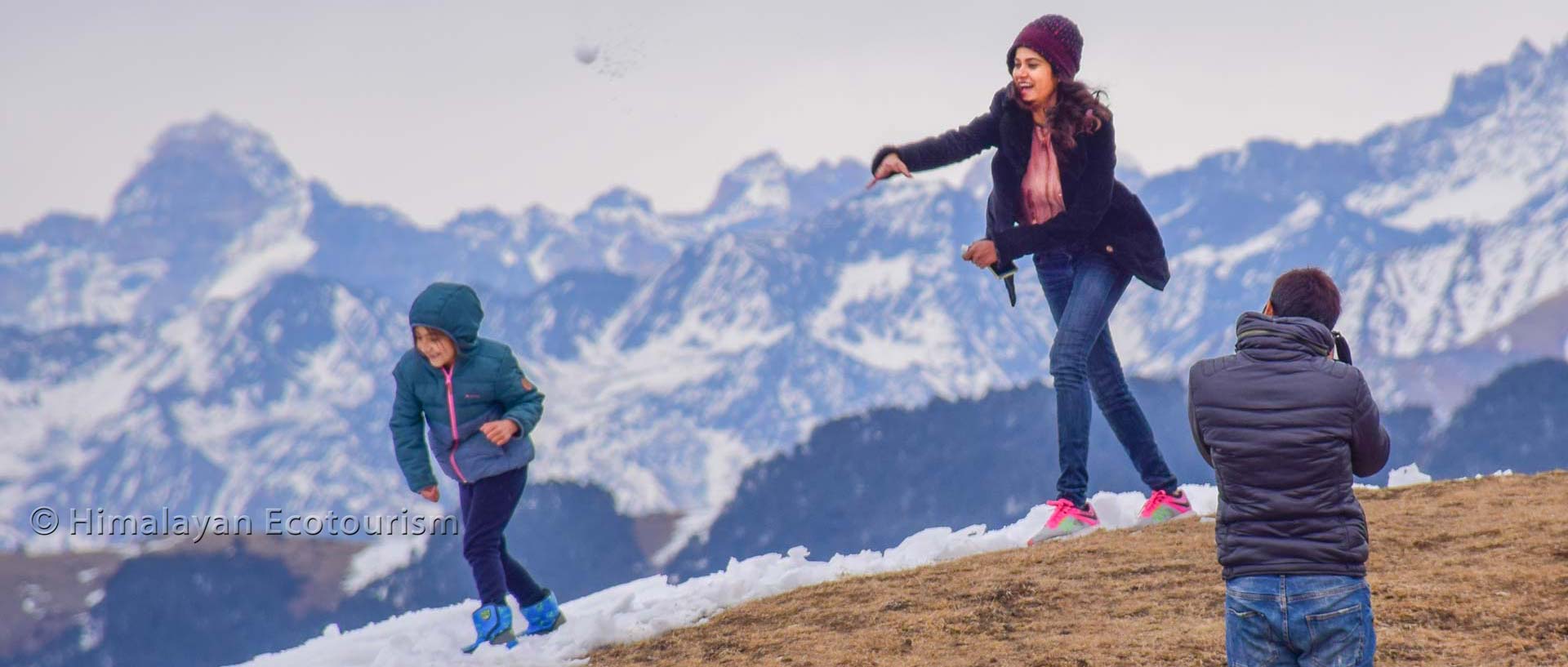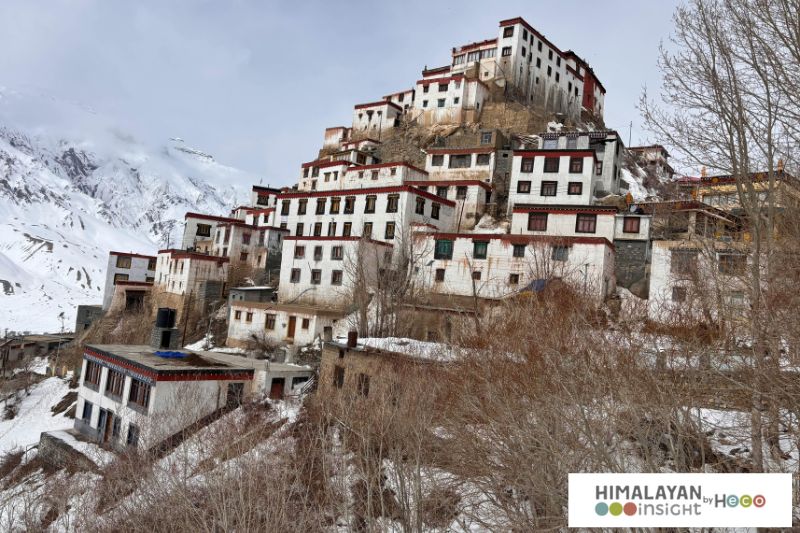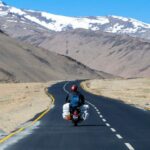Top 10 des sites touristiques à visiter dans la vallée de Spiti en 2025
Vous vous demandez probablement ce qui fait de la vallée de Spiti une destination incontournable. En bref : c'est l'un des rares endroits où vous trouverez d'anciens monastères, des lacs gelés, des villages d'altitude et la beauté brute de l'Himalaya, le tout en un seul voyage. De l'exploration de temples sacrés au camping sous un ciel étoilé, la liste des choses à faire dans la vallée de Spiti en 2025 est plus passionnante que jamais.
Saviez-vous? La vallée de Spiti, située entre le Tibet et l'Himachal Pradesh, ne reçoit qu'environ 250 mm de précipitations par an, ce qui en fait l'une des régions les plus sèches d'Inde. Ce relief aride, mais pourtant magnifique, donne aux sites touristiques de la vallée de Spiti une impression d'être sur une autre planète.
Et devinez quoi ? Le tourisme ici ne se résume pas à des visites touristiques. Vous rencontrerez les communautés locales, séjournerez dans des hébergements éco-responsables et repartirez avec des histoires inoubliables. Que vous soyez amateur de moments de calme ou d'exploration hors des sentiers battus, voici les meilleurs endroits touristiques de la région. Vallée de Spiti pour votre projet de voyage 2025.
À la découverte des meilleurs sites touristiques de Spiti en 2025
Ces lieux soigneusement sélectionnés vous offrent un mélange d'histoire, de nature et de saveurs locales authentiques. Temples sacrés, lacs glacés et autres lieux d'intérêt possèdent chacun leur propre essence, ce qui ajoute de la valeur à votre visite.
1. Temple de Trilokinath
Ce temple du VIIIe siècle est sacré pour les hindous et les bouddhistes. Construit sur le site d'un ancien vihara, le bâtiment actuel abrite une statue d'Avalokiteshvara à six bras datant d'environ le XIIe siècle. L'expérience donne presque l'impression d'entreprendre un voyage vers l'un des joyaux cachés du monde, entre nature et civilisation.
- Heure de pointe : Août, pendant la fête locale.
- Conseil d'initié : La lumière du matin sur les murs blancs favorise la méditation et la réflexion paisibles.
- Ce que vous en retirez : Un lieu pour faire une pause, réfléchir et se connecter, avec à la fois la tradition et l'air de la montagne.
2. Village de Tashigang et Suraj Tal
Tashigang est un ensemble de maisons en pierre, une étape idéale pour les amoureux du ciel bleu. Non loin de là, le Suraj Tal, situé à environ 4 950 m d'altitude, est le troisième plus haut lac d'Inde.
- Accéder: Route de montagne accidentée, à privilégier à partir de juillet.
- Pourquoi visiter : Un soleil éclatant, des reflets surnaturels et très peu de touristes.
- Conseil de pro : Les nuages peuvent arriver rapidement, alors prenez des photos tôt.
3. Parc national de Pin Valley
C'est l'un des sites touristiques les plus prisés de la vallée de Spiti pour sa faune. Des léopards des neiges aux bouquetins de l'Himalaya, le parc est un paradis pour les photographes.
- Pourquoi c'est différent : Contrairement à la plupart des parcs himalayens, celui-ci se trouve dans un climat désertique froid.
- Informations locales : Les guides du village de Mudh sont des pisteurs d'animaux sauvages ; ils connaissent les vallées comme personne d'autre.
4. Village de Nako
Nako n'a rien d'extraordinaire. C'est un village tranquille près de la frontière tibétaine, avec un lac calme, des maisons en pierre et des ruelles étroites. Mais c'est là tout son charme.
- Visitez ceci pour : Soirées tranquilles au bord de l'eau, promenades dans les villages et expériences culturelles tibétaines-bouddhistes.
- Conseils de séjour : Le monastère local organise des séances d'enseignement qui vous permettent d'apprendre à fabriquer des thankas artisanaux.
5. Kibber
L'un des villages carrossables les plus hauts du monde (14 200 m), Kibber offre plus que de l'altitude, c'est ressentir le silence des montagnes.
- Pourquoi il est sur votre liste : Il fait partie d'une réserve faunique et se trouve à proximité du monastère de Key.
- Charme local : Les séjours chez l'habitant gérés par des familles vous offrent de véritables Thukpa et des histoires que vous ne trouverez pas en ligne.
- Alerte faune : Gardez les yeux ouverts pour apercevoir des moutons bleus au crépuscule.
6. Monastère de Gue et Dhankar
Gué abrite le moine momifié naturellement, au cœur de nombreux débats et légendes. À proximité, Monastère de Dhankar se perche de façon spectaculaire sur les falaises.
- Le décor : A plus de 300 m au dessus de la rivière, construit comme un fort.
- Visitez pour : Le lever du soleil au sommet du monastère offre une vue épique sur la vallée.
- Faites ceci : Descendez jusqu'à Shichilling, sirotez du thé au beurre et imprégnez-vous de tout cela.
7. Monastère de Tabo et lac Dhankar
Tabo, surnommée « l'Ajanta de l'Himalaya », existe depuis 996 après J.-C. et abrite des peintures murales inestimables, des statues et une école d'enseignement.
- Pourquoi c'est incontournable : C'est le plus ancien monastère bouddhiste d'Inde encore en activité.
- Trésor abandonné : Marcher jusqu'à Lac Dhankar, un endroit calme en haute altitude (4 140 m) au-dessus du monastère.
- Ce qu'il faut retenir : Emportez de l'eau et des collations, pas de commerces en altitude.
8. Chandra Taal et Kaza
Chandra Taal ou « lac de la Lune » se trouve à environ 4 300 m, à proximité du col de Kunzum (4 551 m) et est accessible via un parcours hors route de 12 km.
- Moment magique : Le camping sous la Voie Lactée est un incontournable.
- Alors, retour à Kaza, le centre culturel de Spiti.
- Aperçu de Kaza : Il regorge de cafés, de boutiques et même d'une boulangerie allemande.
9. Monastère de Key et route de Kibber à Key
Le monastère de Key, situé à environ 4 166 m, est un centre bouddhiste tibétain fonctionnel, vieux de plusieurs décennies, avec des manuscrits rares et des salles de prière.
- Comment s'y rendre : Depuis Kibber, marchez ou prenez un bus local qui part tôt le matin.
- Note du forestier : La meilleure lumière pour les photos est tôt le matin ou en fin d'après-midi.
10. Col de Kunzum
Vous traversez ceci sur l'autoroute Manali–Kaza, 15 virages serrés jusqu'à 4 551 m :
- Pourquoi arrêter : C'est la porte d'entrée de Spiti, et beaucoup s'arrêtent au petit temple (Kunzum Mata).
- En regardant vers l'avenir, Un tunnel prévu pourrait bientôt rendre cette route ouverte toute l'année. Pour l'instant, il faut s'attendre à une saisonnalité.
Comment se rendre à Spiti
Vous avez deux itinéraires : via Manali ou Shimla-Kinnaur.
- Route Manali-Kaza (ouvert de mi-juin à début octobre) : pittoresque, plus rapide, mais les altitudes plus élevées signifient des routes accidentées et un risque de MAM.
- Itinéraire Shimla – Reckong Peo – Kaza (ouvert plus longtemps) : Montée plus douce, plus longue, mais meilleure pour une acclimatation progressive.
Des bus et des taxis collectifs desservent les deux extrémités. Vous pouvez également louer une voiture privée à Manali ou Shimla.
Carte de la vallée de Spiti et conseils de navigation
Ne vous fiez pas uniquement à Google Maps, surtout après Kaza. La connexion Internet est instable et les baisses de signal sont normales.
Conseil pratique : Munissez-vous d'une carte imprimée de la vallée de Spiti ou téléchargez des cartes hors ligne. Les villageois et les commerçants locaux sont souvent plus utiles que la technologie.
Permis de ligne intérieure de Spiti : ce que vous devez savoir
Les ressortissants étrangers ont besoin d'un permis de zone protégée (PAP) pour visiter des zones comme Kaza, Dhankar et Tabo.
- Vous pouvez l'obtenir auprès du bureau DC à Shimla, Reckong Peo ou Manali.
- Les citoyens indiens n'ont pas besoin de permis pour le Spiti intérieur, mais peuvent en avoir besoin pour certaines routes frontalières.
- Gardez à portée de main 3 à 4 photos d’identité et des photocopies de pièces d’identité.
Météo dans la vallée de Spiti – Quand y aller ?
L'été (de mai à septembre) est idéal. Les routes sont ouvertes, les hébergements chez l'habitant sont fonctionnels et vous pouvez accéder à la plupart des destinations. Lieux à visiter à Spiti avec facilité.
- Mai–juin : Idéal pour les débutants
- Juillet-août : Plus de verdure, mais des glissements de terrain sont possibles
- Septembre: Parfait pour la photographie avec une lumière dorée
En hiver ? Réservé aux voyageurs expérimentés. Attendez-vous à des barrages routiers, des nuits glaciales et des options limitées.
Forfaits dans la vallée de Spiti – Devriez-vous y aller seul ou réserver une excursion ?
Spiti est isolé, mais cela ne signifie pas qu'il est impossible de l'explorer par vous-même.
Vous pouvez trouver des forfaits dans la vallée de Spiti qui conviennent à toutes les bourses, offrant tout, des road trips de 5 jours aux circuits immersifs de 15 jours.
Voici ce que la plupart des forfaits couvrent :
- Transport (depuis Manali ou Shimla)
- Séjournez chez l'habitant ou dans des camps
- Permis et guides
- Visites de tous les principaux sites touristiques de la vallée de Spiti
Si vous manquez de temps ou n'êtes pas très confiant pour conduire sur des routes de montagne, alors acheter une visite guidée serait la meilleure option.
Séjourner à Spiti – Où dormir ?
En 2025, de plus en plus d'hébergements éco-responsables voient le jour dans les villages. Vous pourrez séjourner dans :
- Kaza: Idéal pour les cafés et la connectivité
- Kibber et Dhankar : Idéal pour les séjours chez l'habitant et les promenades dans la nature
- Mudh (Vallée de Pin) : Idéal pour les amoureux de la faune
- Tabo et Nako : Des évasions tranquilles pour les écrivains, les lecteurs et les penseurs
Évitez les grands hôtels. Privilégiez les restaurants locaux. Vous y trouverez une meilleure cuisine, de meilleures histoires et vous soutiendrez les familles locales.
Autre chose : ayez toujours de l'argent liquide sur vous. Les distributeurs automatiques sont rares et les cartes ne fonctionnent souvent pas.
Un récit personnel du sentier
J'ai séjourné à Tabo chez une famille qui n'avait jamais quitté Spiti. Ils m'ont servi du Thukpa fumant au coin du feu. Ce soir-là, j'ai réalisé à quel point ils étaient fiers de leur maison et tout ce que j'avais encore à apprendre.
Ce genre d'histoires n'apparaît pas sur Instagram. On ne les ressent que lorsqu'on y est vraiment.
Quoi emporter – Vrai discours
Peu importe quand vous partez, faites vos bagages intelligemment :
- Couches thermiques, même en été
- Crème solaire et baume à lèvres (le soleil est dur)
- Banque d'alimentation et lampe torche
- Médicaments personnels et comprimés contre le mal des montagnes
- Des collations comme des fruits secs, des barres énergétiques
- Votre pièce d'identité et votre itinéraire imprimé
Oh, et ayez toujours, toujours de l’eau sur vous.
Attendez avant de faire défiler : une note émotionnelle rapide
On ne se rend pas simplement dans la vallée de Spiti. On la ressent.
Si vous cherchez un signe pour vous éloigner des endroits bondés et vous imprégner de la beauté brute, c'est celui-ci.
Préparez votre sac, marquez la carte et prenez votre temps. 2025 pourrait être votre année.
Planifiez votre voyage dans l'Himachal Pradesh en toute confiance
Voilà. La vallée de Spiti est authentique, accessible et enrichissante, non pas parce qu'elle est tendance, mais parce qu'elle reste fidèle à ses racines. Que vous recherchiez des monastères, des lacs ou simplement un peu de calme loin de la foule, Himalayan Ecotourism Vous soutient. Faites en sorte que cela compte. Allez-y doucement. Allez-y avec détermination. Que 2025 soit l'année où vous y parviendrez enfin. Voyage dans l'Himachal Pradesh arriver.
Prêt à écouter les chants anciens de Tabo, à vous refléter devant le miroir bleu de Chandra Taal ou à savourer un thé au beurre dans une maison d'hôtes de montagne ? Avec Himalayan Ecotourism qui vous guide, vous découvrirez le Spiti, et pas seulement le verrez.
Questions fréquemment posées
Q : Quels sont les lieux touristiques incontournables de la vallée de Spiti ?
Le monastère de Tabo, le lac Dhankar, Chandra Taal, Kibber et la vallée de Pin figurent en tête de liste. Tous sont accessibles par la route en été.
Q : Combien de jours me faut-il pour visiter les sites de la vallée de Spiti ?
Minimum 7 jours du côté de Manali, 10 jours si vous faites un circuit via Shimla et Manali.
Q : Spiti est-il sûr pour les femmes voyageant seules ?
Oui, surtout en été. Les locaux sont serviables et les séjours chez l'habitant sont plus sûrs que les camps isolés.
Q : Dois-je m'acclimater à Spiti ?
Absolument. Kaza est à plus de 3 800 mètres d'altitude. Hydratez-vous, évitez l'alcool le premier jour et reposez-vous bien.
Q : Quel itinéraire est le meilleur : Manali ou Shimla ?
La route de Shimla offre une montée plus douce et est accessible plus longtemps. La route de Manali est pittoresque, mais plus raide et plus risquée si vous n'êtes pas habitué à l'altitude.






